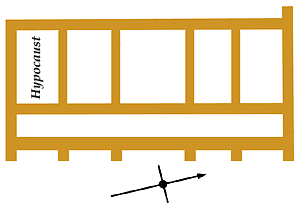
RBH Home
Maps & Travels
Articles
Legends
Towns & Villages
Castles & Houses
Churches
Biographies
Gentry
Family History
Odds & Ends
Mail David
Cornhill Farm Villa
West Challow, Berkshire
 The
Roman Villa at Cornhill Farm in West Challow was apparently already
well-known to local people by the mid-1850s, but it was not until twenty
years later that a local antiquary was able to examine the building in
some detail. Unfortunately, this was not due to a systematic
archaeological excavation, but through observations made during the
wholesale destruction and removal of the remains by farm labourers in the
Autumn of 1876. A rather wordy description of his findings subsequently
appeared in volume 33 of the Archaeological Journal, but, sadly, it
reveals rather little about the villa and its inhabitants.
The
Roman Villa at Cornhill Farm in West Challow was apparently already
well-known to local people by the mid-1850s, but it was not until twenty
years later that a local antiquary was able to examine the building in
some detail. Unfortunately, this was not due to a systematic
archaeological excavation, but through observations made during the
wholesale destruction and removal of the remains by farm labourers in the
Autumn of 1876. A rather wordy description of his findings subsequently
appeared in volume 33 of the Archaeological Journal, but, sadly, it
reveals rather little about the villa and its inhabitants.
The villa was positioned in an idyllic spot on the Berkshire Downs, commanding delightful views over the Vale of the White Horse to the north. It is only half a mile from the prehistoric Icknield Way which was much used in Roman times. Only one building was uncovered: a 82ft by 36ft rectangular house, with 3ft thick walls, divided into five rooms. Along its eastern frontage was a long heavily-buttressed corridor giving access to each. The large central room was presumably a reception hallway. That at the southern end had its own brick tiled hypocaust (underfloor heated system) and may well have been the triclinium (dining-room). The other rooms must have housed a kitchen and sleeping accommodation. The walls were apparently plastered in a dull red colour, but no evidence of other decoration was found. Apparently some of the foundations walls descended to a depth of some 12ft!
Amongst large amounts of pottery recovered were some plain pieces of Samian ware. Other articles unearthed included a number of iron fixings, such as door hinges, and a few shards of thick green glass, probably from glass vessels. Animal remains showed something of the inhabitants’ diet as well as, perhaps, some of the animals farmed at the site: mutton, beef, venison, poultry and game were all in evidence. The Romans here were, apparently, also partial to snails and oysters.
The few coins preserved show that this simple farm building was occupied from the 2nd to the 4th centuries. There were probably associated boundary ditches and agricultural structures, perhaps of wood, but none were recognised.
Based on the work of E.C. Davey (1876)
